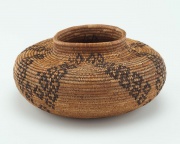Difference between revisions of "Fiber"
Jump to navigation
Jump to search
| Line 1: | Line 1: | ||
| − | [[File:99.134-SC58897.jpg|thumb|]] | + | [[File:99.134-SC58897.jpg|thumb|<br>MFA# 99.134]] |
== Description == | == Description == | ||
A long, thin filament with a length at least 100 times its diameter. Fibers are used to make fabric, paper, mats and as fillers and strengtheners in composite materials. | A long, thin filament with a length at least 100 times its diameter. Fibers are used to make fabric, paper, mats and as fillers and strengtheners in composite materials. | ||
| − | + | * [[Animal fibers|Animal]]: [[wool]], [[alpaca]], [[mohair]], [[angora]], and [[silk]]. | |
| − | + | * [[Vegetable fiber|Vegetable]]: [[abaca]], [[coir]], [[cotton]], [[hemp]], [[jute]], [[kapok]], [[kenaf]], [[linen]], [[Piña]], [[ramie]], [[sisal]] | |
| − | + | * [[Synthetic fiber|Synthetic]]: [[rayon fiber|Rayon]], [[nylon fiber|Nylon]], [[acetate fiber|Acetate]], [[polyester fiber|Polyester]], [[acrylic fiber|Acrylic]]. | |
| − | + | * [[Mineral fiber|Mineral]]: [[asbestos]], [[glass fiber|Glass]], [[carbon|carbon]], [[tungsten]]. | |
| − | |||
| − | |||
| − | |||
The types of fiber are characterized as: | The types of fiber are characterized as: | ||
| − | + | * staple: short fibers. | |
| − | + | * [[monofilament|monofilaments]]: continuous single fibers. | |
| − | + | * [[tow]]: a continuous strand of bundled but untwisted fibers. | |
| − | + | * [[yarn]]: a continuous strand of twisted fibers. | |
| − | |||
| − | |||
| − | |||
== Synonyms and Related Terms == | == Synonyms and Related Terms == | ||
| Line 26: | Line 20: | ||
fibers; fibre (Br., Fr.); fibra (Esp.); vezel (Ned); fibrous substance; | fibers; fibre (Br., Fr.); fibra (Esp.); vezel (Ned); fibrous substance; | ||
| − | == | + | == Physical and Chemical Properties == |
Fibers are characterized by their shape, strength, elasticity, flexibility, weight, stability and ability to absorb moisture | Fibers are characterized by their shape, strength, elasticity, flexibility, weight, stability and ability to absorb moisture | ||
| − | |||
| − | |||
| − | |||
| − | |||
== Comparisons == | == Comparisons == | ||
| Line 42: | Line 32: | ||
[[media:download_file_51.pdf|Fiber Burn Tests]] | [[media:download_file_51.pdf|Fiber Burn Tests]] | ||
| − | + | == Resources and Citations == | |
| − | == | + | * G.Cook, ''Handbook of Textile Fibres:I. Natural Fibres'', 5th edition, Merrow Publishing Co., Durham, England, 1984. |
| − | |||
* ''Fairchild's Dictionary of Textiles'', Phyllis G.Tortora, Robert S. Merkel (eds.), Fairchild Publications, New York City, 7th edition, 1996 | * ''Fairchild's Dictionary of Textiles'', Phyllis G.Tortora, Robert S. Merkel (eds.), Fairchild Publications, New York City, 7th edition, 1996 | ||
| Line 65: | Line 54: | ||
* Theodore J. Reinhart, 'Glossary of Terms', ''Engineered Plastics'', ASM International, 1988 | * Theodore J. Reinhart, 'Glossary of Terms', ''Engineered Plastics'', ASM International, 1988 | ||
| − | * Art and Architecture Thesaurus Online, | + | * Art and Architecture Thesaurus Online, https://www.getty.edu/research/tools/vocabulary/aat/, J. Paul Getty Trust, Los Angeles, 2000 |
[[Category:Materials database]] | [[Category:Materials database]] | ||
Revision as of 11:57, 7 August 2022
Description
A long, thin filament with a length at least 100 times its diameter. Fibers are used to make fabric, paper, mats and as fillers and strengtheners in composite materials.
- Animal: Wool, Alpaca, Mohair, Angora, and Silk.
- Vegetable: Abaca, Coir, Cotton, Hemp, Jute, Kapok, Kenaf, Linen, Piña, Ramie, Sisal
- Synthetic: Rayon, Nylon, Acetate, Polyester, Acrylic.
- Mineral: Asbestos, Glass, Carbon, Tungsten.
The types of fiber are characterized as:
- staple: short fibers.
- monofilaments: continuous single fibers.
- Tow: a continuous strand of bundled but untwisted fibers.
- Yarn: a continuous strand of twisted fibers.
Synonyms and Related Terms
fibers; fibre (Br., Fr.); fibra (Esp.); vezel (Ned); fibrous substance;
Physical and Chemical Properties
Fibers are characterized by their shape, strength, elasticity, flexibility, weight, stability and ability to absorb moisture
Comparisons
Properties of Synthetic Fibers
Resources and Citations
- G.Cook, Handbook of Textile Fibres:I. Natural Fibres, 5th edition, Merrow Publishing Co., Durham, England, 1984.
- Fairchild's Dictionary of Textiles, Phyllis G.Tortora, Robert S. Merkel (eds.), Fairchild Publications, New York City, 7th edition, 1996
- Hoechst Celanese Corporation, Dictionary of Fiber & Textile Technology (older version called Man-made Fiber and Textile Dictionary, 1965), Hoechst Celanese Corporation, Charlotte NC, 1990
- The Dictionary of Paper, American Paper Institute, New York, Fourth Edition, 1980
- E.J.LaBarre, Dictionary and Encyclopedia of Paper and Paper-making, Swets & Zeitlinger, Amsterdam, 1969
- R. J. Gettens, G.L. Stout, Painting Materials, A Short Encyclopaedia, Dover Publications, New York, 1966
- G.S.Brady, Materials Handbook, McGraw-Hill Book Co., New York, 1971
- Mary-Lou Florian, Dale Paul Kronkright, Ruth E. Norton, The Conservation of Artifacts Made from Plant Materials, The Getty Conservation Institute, Los Angeles, 1990
- Matt Roberts, Don Etherington, Bookbinding and the Conservation of Books: a Dictionary of Descriptive Terminology, U.S. Government Printing Office, Washington DC, 1982
- A.Lucas, J.R.Harris, Ancient Egyptian Materials and Industries, Edward Arnold Publishers Ltd., London, 4th edition, 1962
- Theodore J. Reinhart, 'Glossary of Terms', Engineered Plastics, ASM International, 1988
- Art and Architecture Thesaurus Online, https://www.getty.edu/research/tools/vocabulary/aat/, J. Paul Getty Trust, Los Angeles, 2000
